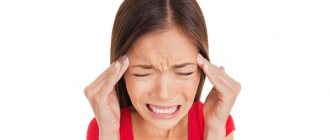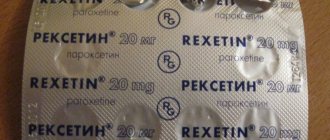: Reading time:
A psychotherapist with more than 14 years of experience, Krailina Irina Sergeevna, talks about effective methods of self-help for panic attacks, how they work, and the role of psychotherapy.
A person who has experienced a panic attack for the first time thinks that something extraordinary, terrible, catastrophic has happened to him.
Many of my patients, when they learn ways to control their emotions, thoughts and body, exclaim: “Oh, if only when this happened for the first time, someone told me that this is a disorder well known to doctors and psychologists, that it can be treated, and most importantly “They don’t die from it!”
After all, then, at the very beginning, there was one most terrible thought that covered everything in the world like a black cloud: “No one knows what’s wrong with me. I will die".
Therefore, a person tries to get first aid by calling an ambulance, or going to a therapist or cardiologist.
Many people try to fight this disorder on their own, looking for recommendations and advice on how to get rid of panic attacks. Usually on the Internet. There is a lot of information there, often it is scattered and contradictory.
Therefore, I will try to systematize information on recommendations and methods of self-help and talk about the benefits of psychotherapy.
For those who want to better understand the topic, the article contains “More details” blocks: you need to click/tap on them for additional information to appear. If your goal is to learn only about self-help techniques, just read the plain print.
Learn more about the mechanism of development and symptoms of panic attacks
Click on the title to read the text
A panic attack is an unpredictable attack of acute anxiety (panic) with bodily symptoms for which the autonomic nervous system (hereinafter referred to as the ANS) is responsible.
Scheme 1. How the autonomic nervous system (ANS) works
In an individual, these symptoms may be present in full or in part:
- heartbeat;
- rise in blood pressure;
- frequent shallow breathing;
- feeling of suffocation, tightness in the chest;
- goosebumps;
- cold extremities;
- dizziness;
- pallor;
- sweating;
- urge to defecate;
- nausea;
- trembling in hands.
These symptoms are a manifestation of autonomic crises (sympathetic-adrenal, vagoinsular or mixed). Often the attack is accompanied by fear of death, loss of control or madness, as well as a feeling of unreality of what is happening or change in one’s self.
Lasts for minutes and ends with the passage of a large amount of light-colored urine. The person feels broken and empty.
Vegetative crises can be a manifestation of certain somatic diseases (endocrine, cardiovascular system), can occur during pregnancy, taking certain medications, or occur as isolated episodes against the background of overwork or alcohol abuse.
When doctors have ruled out somatic pathology, but panic attacks recur, it is more correct to call it a panic disorder.
The reason for the recurrence of panic attacks is a special form of thinking (when anxious traits are combined with perfectionism, the need to control everything) plus instability of the autonomic nervous system (what doctors used to call vegetative-vascular dystonia).
After the first panic attack, a person is in constant anxious anticipation of its repetition. The slightest unpleasant sensation in the body or just a thought can trigger a cascade of somato-vegetative reactions that support and reinforce each other through the mechanism of a vicious circle and lead to panic.
To clearly explain how different self-help methods work, let’s consider a person as an integral system and highlight 4 components:
- the human body;
- his emotions;
- thoughts;
- the external environment with which it interacts.
These components interact with each other and influence each other.
An example of the interaction of body, emotions, thoughts and environment
Click on the title to read the text
For example, support from the environment, family, gives confidence (the thought) that help will be provided in any case. The level of anxiety (emotions) temporarily decreases and vegetative symptoms go away (body). The trouble is that environmental support does not completely eliminate panic disorder. She only supports the belief that one cannot cope with the disorder on one’s own.
Self-help for panic attacks: body
The most common recommendations and advice on self-help regarding the body are:
- intense exercise in the morning and (or) physical activity at the first signs of anxiety;
- long walks in the fresh air;
- deep calm breathing, or “diaphragmatic breathing”, or “belly breathing”, other types of breathing exercises;
- avoidance of alcohol and stimulants;
- cold and hot shower;
- sufficient sleep;
- plenty of warm drinks;
- medicines, herbal medicine, homeopathy;
- acupuncture.
Separately, it should be said about methods of targeted activation of the parasympathetic division of the ANS and reducing heart rate by inducing specific reflexes:
- according to Aschner - close your eyes and use the pads of your thumbs to press intensely on the eyeballs for 15–20 seconds;
- “diving dog” reflex - hold your breath and immerse your face in a basin of ice water;
- Valsalva reflex - strain at the height of a deep breath;
- induce a gag reflex (the urge to vomit, but not vomiting itself) - press on the root of the tongue.
Attention! These actions are contraindicated in the following conditions:
- severe chest pain;
- shortness of breath and cough with foamy sputum;
- severe weakness, decreased blood pressure;
- convulsions, disturbances of sensitivity and movement in the limbs.
- loss of consciousness.
These methods work “through the body” - they affect the autonomic nervous system through one of three mechanisms:
- Promote relaxation in its sympathetic department.
- Activate the parasympathetic department.
- Harmonize and stabilize their activities.
How some self-help methods affect the ANS
Click on the title to read the text
- For example, intense physical activity releases tension in the sympathetic part of the autonomic nervous system - it allows you to “blow off steam.”
- Deep breathing and inducing vagal reflexes stimulate the parasympathetic system, which is an antagonist to the sympathetic system, thus balancing it.
- Avoiding stimulants allows you to avoid excessive stress on the sympathetic department.
- A contrast shower balances both departments.
- Sufficient walks and sleep help restore the body's own strength and resources.
“Physiological” or “mental” depression: how to determine the cause of the disease
The first thing to remember is that panic attacks do not appear out of the blue; there is always a reason for their “awakening”. If a person does not have an innate predisposition to a depressive state, there have been no significant events in life that “knocked him out of the rut”, in 90% of cases we are talking about problems with the physical state of vital systems - cardiovascular and circulatory. The cause of uncontrollable panic and reluctance to enjoy life in the case of osteochondrosis is degeneration of vertebral cartilage in one form or another, which leads to disruption of the functioning of surrounding nerve roots and blood vessels. The resulting protrusions, hernias or other damage to the intervertebral disc lead to compression of the vessels providing blood supply to the brain. In 60% of cases, “advanced” osteochondrosis leads to oxygen starvation of the brain. Trying to normalize its condition, the “main organ” gives alarming signals, including those of a psychological nature.
Self-help for panic attacks: thoughts and emotions
Recommendations regarding thoughts and emotions:
- switch thoughts using distracting actions;
- reconsider your attitude towards health and death;
- determine with what thought it all began and prove to yourself the absurdity of this thought;
- Convince yourself that you can live with panic disorder;
- meditate;
- keep a diary;
- read a prayer.
You may notice that some self-help methods involve the body, emotions, and thoughts. For example, meditation. Performing complex breathing techniques not only stimulates the parasympathetic part of the ANS, but also changes the gas composition of the blood and switches attention.
Changes in one area lead to changes in another. For example, thoughts-memories of a pleasant event evoke pleasant emotions.
Comprehensive treatment of panic disorder
Panic disorder is an extremely common, chronic disease that manifests itself at a young, socially active age. Its prevalence, according to epidemiological studies, is 1.9–3.6%. It is observed 2–3 times more often in women aged 20–30 years. In the modern American classification DSM-IV, panic disorder is included in the class “Anxiety disorders” and is divided into two independent headings: “Panic disorder without agoraphobia” and “Panic disorder with agoraphobia”. Following DSM-IV, the International Classification of Mental Diseases, 10th Revision (ICD-10) included panic disorders under the heading “Neurotic, stress-related, and somatoform disorders.” In this section, “Panic disorders” were included in the class “Other anxiety disorders,” and “Agoraphobia with panic disorder” was included in the class “Anxiety-phobic disorders.” At the same time, domestic researchers rightly assess the symptom complex “panic disorder” as nosologically nonspecific, which can be observed not only in neuroses, but also in affective disorders (depression), various forms of schizophrenia.
The main (core) syndrome of panic disorder is repeated, unexpected panic attacks. A panic attack usually occurs against the background of psychogenic factors (the climax of a conflict, acute stress), as well as biological (hormonal changes, onset of sexual activity, abortion, taking hormonal drugs) and physiological (alcoholic excesses, first use of drugs, insolation, physical activity) factors. A panic attack, however, can also occur autochronically, in the absence of previous emotional and physical stress, against the background of the patient’s daily activities.
Symptoms of a panic attack occur unexpectedly, the attack develops quickly, reaching its peak within 10 minutes. Its usual duration is 20–30 minutes, less often - about an hour. The long duration of the attack casts doubt on the correct classification of panic disorder. It is important that, unlike many paroxysmal conditions, a panic attack is not characterized by a prodromal period (aura). The post-attack period is characterized by general weakness and weakness. Some patients report a feeling of “relief” after the attack ends. The presence of post-ictal confusion and sleep makes the diagnosis of a panic attack questionable. The frequency of attacks varies from daily to once every few months. Typically, patients experience 2–4 attacks per week.
The attack is characterized by vegetative, mental disorders. The latter include affective disorders, phobias, depersonalization-derealization disorders, hysterical-conversion symptoms and senestopathies. Autonomic disorders are represented by a picture of sympathicotonic crisis, less often mixed or vagoinsular.
The most frequent and persistent symptoms of a panic attack are disturbances in the cardiovascular and respiratory systems. Often, patients, when describing an attack, report a sudden onset of “strong heartbeat”, a feeling of “interruptions”, “stopping”, discomfort or pain in the heart area. Most panic attacks are accompanied by a rise in blood pressure (BP), the numbers of which can be quite significant. As the disease progresses, blood pressure numbers decrease in parallel with the deactualization of fear, which can serve as a reliable diagnostic criterion for the differential diagnosis of hypertension with a crisis course and panic disorder. The most pronounced disorders in the respiratory system: difficulty breathing, a feeling of lack of air with shortness of breath and hyperventilation, “a feeling of suffocation.” Describing the attack, patients report that their “throat was tight,” “the air stopped flowing,” and “it became stuffy.” It is these sensations that force the patient to open the windows, the balcony, and look for “fresh air.” The attack may begin with a feeling of suffocation, and in these cases the fear of death arises as a consequence of “difficulty” in breathing. Less commonly, during a panic attack, gastrointestinal disorders are observed, such as nausea, vomiting, belching, and discomfort in the epigastrium. As a rule, at the time of crisis, dizziness, sweating, tremors with a feeling of chills, “waves” of heat and cold, paresthesia, and cold hands and feet are observed. At the final stage of the attack, polyuria or frequent loose stools are observed. Objectively, changes in complexion, pulse rate, and blood pressure fluctuations are determined, and a dissociation is often found between the subjective registration of vegetative disorders by patients and their severity during an objective examination. The mental components of panic attacks include primarily emotionally charged phobias (fear of death, fear of heart failure, heart attack, stroke, falling, “loss of control” or “fear of madness”). Dysphoric manifestations are also possible (irritability, resentment, aggression), as well as depressive ones - with melancholy, depression, hopelessness, self-pity.
At the same time, panic attacks are observed, in which clear emotional disturbances cannot be identified. In recent years, panic attacks without fear have attracted particular interest. The names of these attacks have many synonyms: “panic without panic”, “somatically manifested panic”, “alexithymic panic”, “masked anxiety”. Such conditions are often observed in patients seeking primary medical care in departments of cardiology and neurology, and are extremely rare among patients in psychiatric clinics. Hysterical-conversion (functional neurological) disorders during attacks are most often represented by a “feeling of a lump in the throat,” aphonia, amaurosis, mutism, numbness or weakness in the limbs; Ataxia and stretching, “twisting,” and “twisting” of the arms are also noted. Derealization and depersonalization disorders are rarely observed: “lightheadedness” in the head, a “dream-like state,” a feeling of “remoteness and separation” from the environment (the so-called “neurotic” or “hysterical” depersonalization).
Treatment of panic disorder
There are several strategies in the treatment of panic disorder: first, stopping the panic attack itself; the second is the prevention (control) of a panic attack and syndromes secondary to panic (agoraphobia, depression, hypochondria, etc.).
To relieve a panic attack, medications and psychophysiological techniques are used. The most effective drugs are benzodiazepines, of which fast-acting drugs are more preferable: diazepam, lorazepam. Average therapeutic doses are used. Both oral and intravenous administration of the drug is possible. Relief of the attack is achieved a few minutes (15–30) after administration of the drug. However, frequent (daily) use of these drugs leads to the development of an addiction syndrome, and they stop working in the usual dosages. At the same time, irregular use of benzodiazepines (“on-demand use”) and the associated rebound phenomenon may contribute to an increase in panic attacks. Psychophysiological methods for stopping paroxysm include: relaxation training, switching to diaphragmatic breathing, “breathing into a bag.”
Stabilizing therapy, aimed at consolidating the results (control of panic attacks), restoring the level of social adaptation, overcoming agoraphobic manifestations (anticipation anxiety, avoidant behavior) and preventing early relapses (4–6 months), includes the prescription of drugs that have an antipanic effect. Currently, the following antipanic drugs are available: tricyclic antidepressants (TADs), selective serotonergic drugs and monoamine oxidase inhibitors (MAOIs).
Tricyclic antidepressants are the first class of drugs that have been found to have a full antipanic effect. The most commonly used drugs of this class for panic disorder include imipramine, clomipramine, and amitriptyline. TADs are the drugs of choice in cases of concomitant depressive disorders and severe agoraphobia.
Treatment with TAD begins with small doses (12.5–25 mg/day), then the dose is gradually increased to a tolerable level (on average by 12.5–25 mg over 3–5 days). The average effective daily dose is usually 150–200 mg/day, rarely reaching 300 mg. An extremely negative property of TADs is the remoteness in time of their anti-panic effectiveness - the first improvement occurs after 2-3 weeks. Sometimes in the first weeks of treatment there is an exacerbation of symptoms. Another important obstacle to the prescription and long-term use of TAD is the wide range of side effects (dry mouth, weight gain, constipation, palpitations, internal tremors).
Another class of antidepressants widely used in the treatment of panic disorder are selective serotonin reuptake inhibitors (SSRIs): fluoxetine (Prozac, Portal, Prodep), fluvoxamine (fevarin, floxifral, Luvox), sertraline (Zoloft), paroxetine (Paxil), citalopram (cipramil). The main disadvantage of this group is the occurrence during the first 2-3 weeks of treatment of hyperstimulation (irritability, insomnia, nervousness) and increased anxiety and panic symptoms. Initial doses are usually minimal (5 mg fluoxetine, 50 mg fluvoxamine, 25 mg sertraline) and within 2 weeks the dose is brought to the average, and then, if necessary, increases or remains the same. Subsequently, even with long-term therapy, the dose does not change. For long-term (maintenance) treatment, these drugs are much more convenient than TAD, due to the lack of anticholinergic and adrenergic effects and possible single administration during the day.
The widespread use of drugs with anti-panic effectiveness contributed to an increase in the interictal period, which, in turn, made it possible to conduct adequate psychotherapy. Psychotherapeutic treatment usually begins to be used at the stage of stabilizing (follow-up) psychopharmacotherapy and continues for some time after stopping medication, greatly facilitating the process of their withdrawal. Currently, the most common treatment for panic disorder is behavioral and, less commonly, cognitive psychotherapy. Its use can reduce the level of anxiety in phobic situations and reduce the fear of expecting an attack. Cognitive psychotherapy is aimed at correcting the fixed misconceptions of patients, according to which patients experience exaggerated reactions to non-life-threatening somatic sensations. Despite the fact that behavioral methods of psychotherapy in the treatment of panic disorder are currently considered the most effective, it is necessary to take into account that, while positively influencing the symptoms of the disease, they can leave neurotic structures formed in childhood unaffected. This, in turn, can end the initial success of treatment and lead to the appearance of new symptoms or the recurrence of old ones. Thus, there is a need to study the effectiveness of other types of psychotherapy and their use in the treatment of panic disorder.
In the department of neuroses and psychotherapy of the NIPNI named after. For a number of years, V. M. Bekhterev has successfully used individual and group personality-oriented (reconstructive) psychotherapy for the treatment of panic disorders, the main goal of which is to achieve positive personal changes (correction of a disturbed system of relationships, inadequate cognitive, emotional and behavioral stereotypes), which leads both to an improvement in the patient’s subjective well-being and elimination of symptoms, and to the restoration of full functioning of the individual. The use of a group form of psychotherapy is all the more justified if, with panic disorder, patients often experience restrictive behavior, social maladjustment, and disturbances in interpersonal functioning. However, given the need to provide psychotherapeutic assistance to an ever-increasing number of patients with panic disorder, without increasing material costs, but while maintaining the degree of effectiveness of the therapeutic intervention, the need for the development and use of short-term group methods of psychotherapy becomes obvious. The staff of the department developed and tested a method of group psychotherapy, combining the theoretical foundations and principles of interpersonal and personality-oriented (reconstructive) psychotherapy. Such integration makes it possible to take into account in therapeutic work the factors of internal (intrapsychic mechanisms) and external (psychosocial factors) determination of personality functioning, while the psychotherapist gets the opportunity to shift the emphasis when analyzing intrapersonal and interpersonal problems. In the process of psychotherapy, focused on correcting inadequate interactions, the patient’s conflictual relationships lose their indispensable and central character. This entails a decrease in the intensity of neurotic symptoms. There is also a decrease in intrapersonal problems, in particular due to an improved attitude towards oneself (increased self-esteem).
Our study examined the effectiveness of short-term interpersonal group psychotherapy and individual person-oriented (reconstructive) psychotherapy in the treatment of panic disorders. We examined 60 patients aged from 18 to 51 years, of whom 42 were women and 18 men. All patients were diagnosed with panic disorder according to ICD-10 criteria. Depending on the treatment received, all subjects were divided into three groups: patients of group 1 received only drug therapy; in patients of group 2, complex treatment was used, including the prescription of pharmacological agents and individual person-oriented (reconstructive) psychotherapy; When treating patients of group 3, drug therapy was used in combination with short-term interpersonal group psychotherapy. Drug therapy included the prescription of the following drugs in various versions: antipsychotics - eglonil, atarax, clopixol; antidepressants - Remeron, Lerivon, Coaxil, Paxil; anxiolytics from the benzodiazepine class - clonazepam, alprazolam.
In order to test the effectiveness of the proposed methods of treating panic disorders, clinical and experimental psychological research methods were used. Methods of experimental psychological research included:
- symptom questionnaire SCL-90;
- method for studying the stages of the psychotherapeutic process URICA;
- integrative anxiety test.
Experimental psychological studies were carried out twice - at the diagnostic stage before treatment and on the last day of the patient's stay in the hospital.
Preliminary data obtained in our study allow us to assume with a reasonable degree of certainty that the combination of drug therapy with short-term interpersonal group psychotherapy (group 3) provides a reduction in the level of symptoms that is more rapid, qualitative and sustainable than monotherapy with drugs (group 1 ) or a combination of individual personality-oriented psychotherapy with anxiolytics (group 2) in patients with anxiety-panic conditions. Motivation for treatment in patients of the 3rd group is formed faster, their readiness for change is much higher and the elaboration of intrapersonal conflicts is better, which ensures a more favorable prognosis and a lower frequency of relapses. The combination of psychopharmacotherapy and group interpersonal therapy improves interpersonal interaction and in a relatively short time increases the adaptive abilities of patients, which is very important in modern socio-economic conditions.
Literature
- Vein A. M., Kolosova O. A. Vegetative-vascular paroxysms. M., 1971.
- Dyukova G.M. Psychovegetative paroxysms: clinical picture, pathogenesis, treatment: Dis. ...Dr. med. Sci. M., 1995.
- Isurina G. L. Mechanisms of psychological correction of personality in the process of group psychotherapy in the light of the concept of relationships//Group psychotherapy. M., 1990. pp. 89–121.
- Karvasarsky B. D., Murzenko V. A. Group psychotherapy for neuroses // Current issues in medical psychology. L., 1974. pp. 70–77.
- Clinical psychology/Ed. M. Perret, W. Baumann. St. Petersburg: Peter, 2002.
- Kolotilshchikova E. A. Methodology of interpersonal group psychotherapy for the treatment of neurotic disorders: Abstract of thesis. dis. ...cand. psychol. Sci. St. Petersburg, 2004.
- Mizinova E. B. Short-term group personality-oriented (reconstructive) psychotherapy for neurotic disorders: Abstract of thesis. dis. ...cand. psychol. Sci. St. Petersburg, 2004.
- ICD-10. International Classification of Diseases (10th revision).
- Psychotherapeutic Encyclopedia / ed. B. D. Karvasarsky. St. Petersburg: Peter, 1998.
- Yalom I. Theory and practice of group psychotherapy. St. Petersburg: Peter, 2000.
M. V. Fursova NIPNI im. V. M. Bekhtereva, St. Petersburg
Reviews about taking "Anaprilin"
People suffering from vegetative-vascular dystonia take many different medications. The problem is that the remedies prescribed by the doctor may not help immediately. And often it is necessary to relieve an attack in a few minutes, as it causes serious discomfort. And those who tried to take Anaprilin for this purpose are very pleased with the effect. Many people constantly buy this medicine, since it is inexpensive and available at any pharmacy. Indeed, with panic attacks, “Anaprilin” really helps, relieving the attack in just a few minutes. It lowers blood pressure, removes fear and anxiety, and calms the heart rate. Therefore, the drug has earned popularity among psychiatrists and neurologists. And patients like its low cost and quick effect.
How can a specialist help with depression?
Depression, especially spontaneous depression, is not a reason to make an appointment with a psychiatrist. Start with something simple - a visit to a therapist. A thorough visual inspection will tell a good specialist a lot. The doctor’s goal is to make a correct diagnosis, on which 90% of the effectiveness of treatment depends. If there is a suspicion of osteochondrosis and the symptoms are associated specifically with this pathology, a laboratory study of blood biochemistry and ultrasound of the vessels of the cervical spine are recommended. After studying the results, it will be possible to decide what caused the panic attack and depression. Treatment is prescribed in accordance with the physical and psychological condition of the patient and is carried out comprehensively. The goal is to simultaneously normalize blood flow in narrowed vessels and relieve a person from emotional exhaustion. Therapeutic measures can be different: taking medications to improve brain function, physiotherapy, prescribing sedatives or antidepressants.
Contraindications to taking the drug
Many people suffering from panic attacks are introduced to this remedy when calling an ambulance. Having felt its quick effect, they go to the pharmacy to buy these “magic” pills. Some even forget to study the instructions, believing that if a medicine is sold without a prescription, then it is safe. But this is absolutely forbidden. "Anaprilin" is a serious drug that has many contraindications.
First of all, this is individual intolerance to propranolol or its other components. The second serious contraindication is low blood pressure. People with hypotension should not take the drug, as blood pressure may drop sharply, leading to fainting or even cardiac arrest. In addition, “Anaprilin” is contraindicated for bradycardia, acute heart failure and some other heart pathologies. It is not recommended to use it for diabetes, Raynaud's disease, bronchial asthma, during pregnancy and breastfeeding.
The danger of uncontrolled use
Many people suffering from panic attacks, having tried Anaprilin, take it constantly. They like its quick action: the heart begins to beat more smoothly, fear disappears, trembling goes away and even their mood improves. Moreover, the drug is sold without a prescription, so people consider it safe. But that's not true. "Anaprilin" for panic attacks can only be an emergency medicine. That is, you can drink it occasionally, only in emergency cases.
If taken uncontrolled, this drug can negatively affect the patient's health. The biggest danger is that this is a medicine to lower blood pressure. It falls, even if it was normal initially. As a result, bradycardia, heart failure, and fainting may develop.
Another danger of constantly taking and exceeding the dose of Anaprilin during panic attacks is that a serious withdrawal syndrome may develop. To understand what it is, you need to understand the peculiarities of the drug’s action. It blocks adrenaline receptors. The body naturally reacts to this by more actively producing adrenaline. But if a person continues to take the drug, new beta-adrenergic receptors begin to form in the body. This leads to the fact that when the medication is abruptly discontinued after long-term use, a powerful surge of adrenaline is formed. As a result, a person feels a panic attack more strongly than before, tachycardia appears, and blood pressure increases significantly.
General characteristics of the drug
Drugs related to adrenergic blockers have been used in medicine for a long time to treat many cardiovascular diseases. And one of the most common is “Anaprilin”. Its main active ingredient is propranolol. It has a blocking effect on all adrenergic receptors located in the heart, blood vessels and bronchi. Due to this, it is often used in neurology, endocrinology, cardiology and psychiatry. "Anaprilin" is prescribed for tachycardia, high blood pressure, angina pectoris, increased anxiety, and alcohol withdrawal.
The drug is available in tablets of 10 and 40 mg of the active substance. Packaged in 50 tablets per package. Its cost ranges from 18 to 80 rubles, depending on the manufacturer.
How to determine that the pathology is caused by osteochondrosis
The following symptoms are typical for panic attacks and depression:
• spontaneity. Anxiety may appear for no apparent reason;
• changes in character: increased aggressiveness or “tearfulness” in a balanced patient, apathy in an active patient, reluctance in sexual intimacy in a loving one;
• feeling of lack of air. Thus, the brain sends a signal about a lack of oxygen to the respiratory organs.
• sleep and appetite disturbances. Anxiety symptoms affect the nervous system. The desire to eat normally disappears, night rest becomes restless, and dreams become chaotic, often nightmarish.
If such symptoms are caused by osteochondrosis, then usually a person can also feel the following “bonuses”: dizziness, sudden changes in pressure (dystonia), headache, periodic numbness of the limbs and facial muscles, hearing and vision impairment.
If at least 2 of the above symptoms coincide, you will not be able to cope with depression and panic attacks on your own. A doctor's help is needed.








